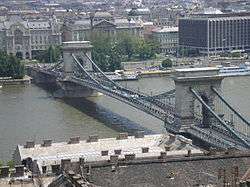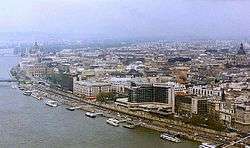Pest, Hungary
Pest (Hungarian pronunciation: [ˈpɛʃt]) is the eastern, mostly flat part of Budapest, Hungary, comprising about two thirds of the city's territory. It is separated from Buda and Óbuda, the western parts of Budapest, by the Danube River. Among its most notable sights are the Inner City, the Hungarian Parliament Building, Heroes' Square and Andrássy Avenue. In colloquial Hungarian, "Pest" is often used for the whole capital of Budapest. The three parts of Budapest (Pest, Buda, Óbuda) united in 1873.


Etymology
According to Ptolemy the settlement was called Pession in ancient times (Contra-Aquincum). Alternatively, the name Pest may have come from a Slavic word meaning "furnace", "oven" (Bulgarian пещ ['pɛʃt]; Serbian пећ/peć; Croatian "peć"), related to the word пещера (meaning "cave"), probably with reference to a local cave where fire burned.[1] The spelling Pesth was occasionally used in English, even as late as the early 20th century,[2] although it is now considered archaic.
History
.svg.png)
On the territory of Pest there have been Celtic and Roman settlements.
During the Middle Ages, Pest was an independent city separate from Buda/Ofen, which became an important economic center during the 11th–13th centuries. The first written mention dates back to 1148.
Pest was destroyed in 1241 Mongol invasion of Hungary, but was rebuilt soon thereafter.
Demographically, in the 15th century Pest was mostly Hungarian, while Buda across the Danube had a German-majority population.[4]
In 1838 Pest was flooded by the Danube; parts of the city were under as much as eight feet of water, and the flood destroyed or seriously damaged three-fourths of the city’s buildings.[5] In 1849 the first suspension bridge, the Széchenyi Chain Bridge, was constructed across the Danube connecting Pest with Buda. Subsequently, in 1873, the two cities were unified with Óbuda to become Budapest.
Notable people
- László Teleki (1811–1861), writer, statesman and magician
- Henrik Weber (1818–1866), painter
- Theodor Herzl (1860–1904), founder of the political Zionist movement
- Harry Houdini (1874–1926), illusionist, escape acts performer
Climate
| Pest | ||||||||||||||||||||||||||||||||||||||||||||||||||||||||||||
|---|---|---|---|---|---|---|---|---|---|---|---|---|---|---|---|---|---|---|---|---|---|---|---|---|---|---|---|---|---|---|---|---|---|---|---|---|---|---|---|---|---|---|---|---|---|---|---|---|---|---|---|---|---|---|---|---|---|---|---|---|
| Climate chart (explanation) | ||||||||||||||||||||||||||||||||||||||||||||||||||||||||||||
| ||||||||||||||||||||||||||||||||||||||||||||||||||||||||||||
| ||||||||||||||||||||||||||||||||||||||||||||||||||||||||||||
See also
- Budapest
- Inner City (Budapest)
- Pest County
- Újpest (New Pest)
- Kispest (Little Pest)
- Pestszentlőrinc (Saint Lawrence of Pest)
- Buda
- Óbuda (Old Buda)
References
- Adrian Room (2006). Placenames of the World. McFarland & Company. p. 70. ISBN 0-7864-2248-3.
- Pesth
- Nyerges, András, ed. (1998). Pest-Buda, Budapest szimbólumai [Budapest arms & colours: throughout the centuries]. Budapest: Budapest Főváros Levéltára. p. 2.
- "Budapest". A Pallas Nagy Lexikona (in Hungarian). Retrieved 2009-11-03.
- Nemes, Robert (2005). The Once and Future Budapest. DeKalb, Ill.: Northern Illinois University Press. p. 107. ISBN 0-87580-337-7.
Further reading
- Beksics, Gusztáv: Magyarosodás és magyarositás. Különös tekintettel városainkra. Budapest, 1883
External links
| Wikivoyage has a travel guide for Pest. |
| Wikimedia Commons has media related to Pest (Hungary). |